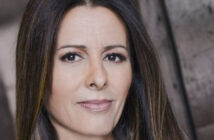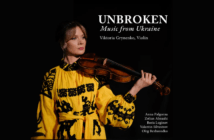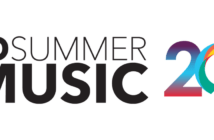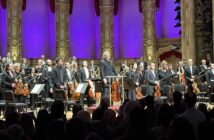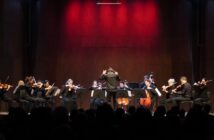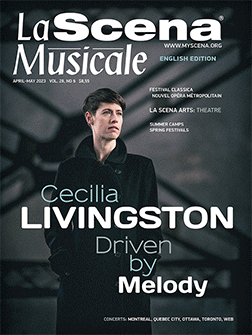
This page is also available in / Cette page est également disponible en:
![]() Francais (French)
Francais (French)
If you go to Canadian violinist Kerson Leong’s Facebook page, you will see a short video of Niccolò Paganini’s Violin Concerto No. 1. The video is clearly of Leong in practice; he is using two mutes on his bridge to dampen the sound. Despite a dense passage of trills, double-stops, and arpeggios—pyrotechnics up and down the finger board—Leong coolly pulls it off, his fingers solid and sure.
In his words, Leong has been getting into his “Prima donna self,” with works by the Italian virtuoso. Recently, he performed I palpiti, Paganini’s variations on Rossini’s “Di tanti palpiti” from Tancredi with Italy’s Camerata Ducale in February, and Concerto No. 1 with the Tucson Symphony Orchestra in March. Although orchestral performances of Paganini are new additions to Leong’s repertoire, he hints at more to come in future seasons.
“For me, it feels like a break. It’s so different from everything else; it’s a different mentality,” Leong said. “When you do Paganini—I don’t want to say that there’s less seriousness there, or less focus on the musical architecture you focus on in Brahms—it’s more you embrace a very particular esthetic and spirit.”
In other words: it’s fun. “You let yourself go,” said Leong with a smile. “It’s very refreshing.”
Seeking Balance, Seeking Inspiration
Even though he is currently “immersed in a million notes,” Leong didn’t need to make a deal with the devil like Paganini to pull off his Concerto No. 1—even with this season’s busy tour schedule and whirlwind of different repertoire.
“It’s always a balance you have to find. For me, I try to get used to practising in short bursts,” said Leong, who describes condensing his practice time to focus on the most rigorous passages. For the rest? “If you can do it in the head, if you can do it in front of the score—that’s great.”
Beyond woodshedding, Leong’s artistic practice includes cultivating moments of inspiration he can use to sustain his performances of demanding works. Sometimes this includes sitting by himself and daydreaming.
“Inspiration is where it all comes from: the vision, the imagination,” Leong explained. “It has become more and more important to me to go on low-power mode when not practising, or just to clear my head out.”
In addition to meditation, Leong has found reading to be a wonderful respite. “It changed my life. I got a Kindle, and it’s changed the way I function,” Leong said with a laugh. “I’ve discovered I really love reading.” The genre does not matter so much as the effect. “Whether it’s fiction, whether it’s stories you can relate with—anything that generates an emotional response.”
Recently introduced to the writing of Japanese author Haruki Murakami, Leong was particularly struck by Kafka on the Shore (2002). “It was a very strange, but very powerful read. I still find myself thinking about it, even after having finished the book a month ago. It was definitely an atmosphere.
“You also find very specific classical music references—the only kind of references you could have if you were a diehard classical music fan. I found out that he is actually very good friends with Seiji Ozawa.”
A Musical Homecoming
Although Leong is an Ottawa native, he feels he has a musical home in Montreal. “A lot of the most memorable experiences I’ve had in my life have taken place in Montreal or the surrounding vicinity,” Leong said. “I have a big soft spot for Montreal.”

Kerson Leong & OM
Chosen by Yannick Nézet-Séguin as artist-in-residence of the Orchestre Métropolitain in 2018-19, he returns to Montreal and environs this April for a run of five performances of the Tchaikovsky Concerto, four with the OM and one with OS Sherbrooke.
“It’s fun to be in that situation because you can embrace this spontaneous element every night because you know we have been working on this vision together,” said Leong. “It’s fun also that all the concerts will be in different venues.”
His relationship with the OM spanning at least a decade, Leong is glad to be returning this spring. “Every time I see these musicians, it feels like I’m meeting with old family. It really does feel like coming home with the Métropolitain.
“When you come back to a group of musicians that you know well, you can really feel at ease,” he said. “That’s a great feeling to have.”
Considered a workhorse of the violin repertoire, the Tchaikovsky Violin Concerto nonetheless has, in Leong’s words, “so much lightness, and dance, and light to convey.”
“This particular concerto is funny because obviously, in the minds of violinists, it is known for being difficult—for being demanding, endurance-wise,” said Leong. “But at the same time, there is a certain dichotomy there.
“It’s interesting to think that (Tchaikovsky) wrote it in a very difficult time of his life, and yet the music comes across as incredibly opposite. There are so many elements there to bring out beauty, or just to please.
“He was very likely inspired by Lalo’s Symphonie espagnole, as well. Again, that’s the kind of piece that doesn’t concentrate on building a musical structure so much as bringing out esthetic beauty, character, and colours.”
Kerson Leong performs the Tchaikovsky Violin Concerto with Orchestre symphonique de Sherbrooke, April 15, and with Orchestre Métropolitain,
April 26, 27, 28 & 29. www.ossherbrooke.com
www.orchestremetropolitain.com
He returns to Montreal for the Montreal Chamber Music Festival June 6 and 8 in trio with Bryan Cheng (cello) and Stewart Goodyear
(piano). www.festivalmontreal.org
An album of the Bruch and Britten Violin Concertos with the London Philharmonia Orchestra under Patrick Hahn will be released on Alpha in May.
Playlist
This page is also available in / Cette page est également disponible en:
![]() Francais (French)
Francais (French)







